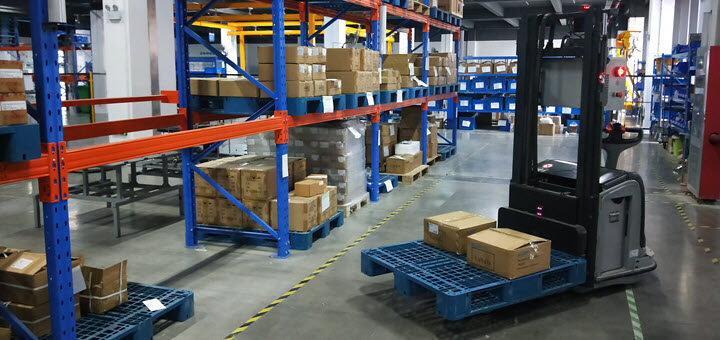7 Cost-Saving Benefits of Automated Guided Vehicles (AGVs)

When deciding whether or not Automated Guided Vehicles (AGVs) would be an ideal fit for your company as you seek to automate your operation, a common place to start is weighing the advantages and disadvantages of AGVs.
While there are many technologies available to streamline any operation, AGVs offer incredible benefits. These systems can be added to your existing operation with little disruption and show immediate improvements once properly calibrated.
Considering AGVs for your operation? Talk with one of our expert consultants.

What are Automated Guided Vehicles (AGVs)?
Automated Guided Vehicles are controlled via computer and carry a load or product autonomously within a warehouse or distribution center facility. These systems require no human or manual input and can effectively transport items without error.
7 Benefits of Automated Guided Vehicles (AGVs)
In exchange for the initial investment that it takes to purchase an AGV, employers save money by eliminating ongoing costs that accompany human personnel: salary, healthcare, retirement benefits, vacation and sick time, overtime pay, etc.
Additionally, machines don’t need to take breaks and can work 24/7, allowing them to quickly recoup their initial investment.
1. Reduced Labor Costs
The most obvious cost saving that comes from implementing automated guided vehicles is a reduction in labor costs because you are either replacing an existing employee or foregoing a new hire.
2. Eliminates Salary and Benefit Increases
Finding employees and training and retaining them is a big challenge. Likewise, employees expect their compensation to grow with their experience level and time with a company. Whether this is through yearly salary increases, bonuses, additional vacation time, better insurance, or a 401k match, with each year that passes, your labor costs are likely to trend up. This means that every year, your labor costs increase.
By replacing personnel with AGVs, you remove this growth in labor expenses. In fact, instead of getting more expensive, AGV use becomes more profitable with each year that passes: Once a machine has operated long enough to recoup the initial investment, any additional proceeds that its use brings in is pure profit (excluding the cost of maintenance, repair, and energy consumption).

3. Eliminates Damage to Structures and Product
People make mistakes, get tired, fatigued, and distracted. They sometimes don’t see an obstacle until they run the forklift into it. Accidents and mistakes happen, but ultimately cost companies money by damaging a product that can no longer be sold and by damaging equipment or structures that then need to be replaced.
AGVs do not have to contend with the same issues that human workers do; they don’t get tired, they don’t get fatigued, they don’t get distracted thinking about lunch. Through their use of sensors, lasers, and cameras, AGVs save money by reducing the damage that human operators can cause.
4. Increased Workplace Safety
Using AGVs increases workplace safety in a number of ways. In addition to removing the human element, which is at the root of many accidents, they can perform tasks that are dangerous to human workers, such as handling hazardous substances, working in extreme temperatures, and moving heavy materials. This ultimately moves personnel out of harm’s way.
AGVs operate in a controlled manner, with smooth and consistent acceleration/deceleration and monitored top speeds—a direct contrast to manual forklift drivers, who can whip around a plant at high speeds and endanger staff.
Increasing workplace safety lowers a number of costs including insurance rates, OSHA penalties (which can top $12,000 in some cases), and time lost due to injury or structural repair.
5. Less Expensive than Fixed Automation Systems
In many cases, AGVs perform similar duties to fixed automation systems (like conveyors). Fixed automation systems can be expensive to implement and often impact workflow during implementation; it takes time to put the systems in place, and sometimes a facility cannot operate during implementation.
AGVs, on the other hand, are less expensive to implement and, more importantly, do not impact operations while being implemented. This leads to less downtime and increased productivity.Additionally, facilities will often need to adjust workflows and layout to accommodate demand and increase flexibility. A fixed automation system, once implemented, is difficult and costly to move; AGVs, on the other hand, can be easily reprogrammed to follow new paths.

6. Reduced Utility Costs
One of the primary benefits of AGVs is that they are able to operate 24/7 and in conditions that humans cannot effectively work, which ultimately increases productivity and the bottom line. Companies that add automated guided vehicles to their workforce often reduce utility costs because AGVs can operate in temperatures higher or lower than humans find comfortable (reducing heating/AC and ventilation costs) and in low-light environments (reducing electricity costs).
7. Increased Inventory Efficiency and Decreased Human Error
When linked with a warehouse execution system (WES) or a warehouse management system (WMS), AGVs easily and automatically track inventory. This lowers costs by removing the need to have a human worker perform inventory.
Increased accuracy of inventory also means that you know exactly how much material you have, allowing you to order materials when you need them. This prevents the loss of time and productivity that can occur if you are waiting for a new shipment to arrive and also prevents the waste of capital that can occur if you order something that you don’t yet need.
Improve Your Operations Efficiency and Save Money
Using automated guided vehicles saves companies money in a slew of ways both direct and indirect. Whether it’s lowered labor costs, a cheaper utility bill, lower insurance premiums, or some other combination of everything above, this ultimately means that using AGVs increases the bottom line and allows you to keep more of your revenue as profit.




